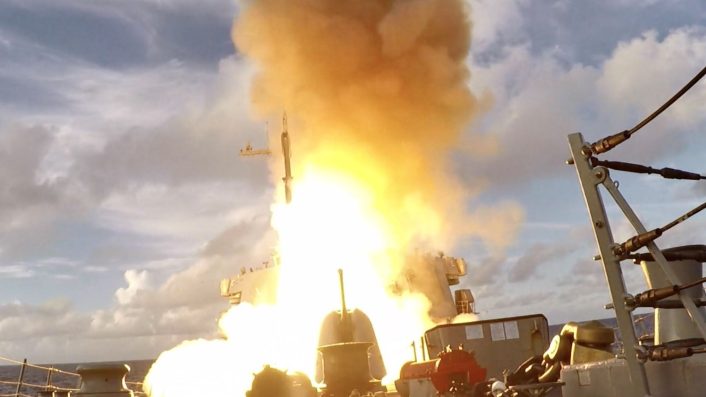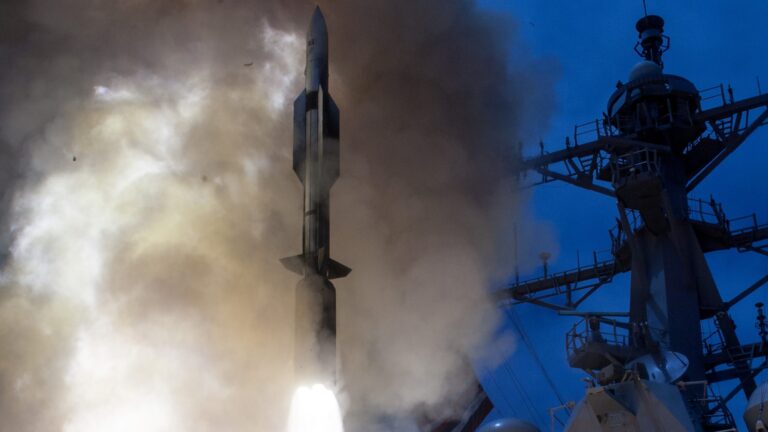While Japan is in the process of massively up-gunning itself with other U.S. weapons, the SM-6 represents a specific strategic capability against ballistic missile threats.
The U.S. State Department has approved the sale of 150 SM-6 Block Is (Standard Missile-6 Block I), worth $900 million, for Japan as part of a BMD (Ballistic Missile Defense) effort in the Pacific, announced the DSCA (Defense Security Cooperation Agency) on Jan. 31, 2025. The SM-6 can be deployed from the JMSDF’s (Japan Maritime Self-Defense Force) existing and future Aegis Weapon System (AWS) warships “to protect Japan and local allied land forces and will significantly improve Japan’s contribution to integrated air missile defense in the Indo-Pacific region.”
Other items in the FMS (Foreign Military Sale) include MK 21 Mod 3 VLS (Vertical Launch System) canisters, components, parts, support, test and handling equipment. While Japan is in the process of massively up-gunning itself with U.S. weapons, including F-35Bs, AGM-158 JASSMs, upgrading its F-15J Eagles and AIM-120 AMRAAMs, the SM-6 purchase represent a specific strategic capability to counter North Korea’s (and to a certain extent China’s) growing ballistic missile arsenal.
“This proposed sale will support the foreign policy goals and national security objectives of the United States by improving the security of a major ally that is a force for political stability and economic progress in the Indo- Pacific region,” the DSCA added. The U.S. Navy and the MDA (Missile Defense Agency) periodically hold BMD exercises in the Pacific. The last such drill, exercise Pacific Dragon 24, was held between July and August 2024 and saw the maiden use of a new IAMD-T (Integrated Air and Missile Defense – Target).
Australia is also a partner in the broader missile defense effort in the Pacific. During the same PD-24 exercise, the Royal Australian Navy (RAN) ship HMAS Sydney test fired an SM-6 for the first time early in Aug. 2024.
🇺🇸🇯🇵 The US State Department has approved a possible Foreign Military Sale to Japan of 150 Standard Missile-6 Block I missiles, plus associated equipment and services for an estimated cost of $900 million.
SM-6 unit cost is ~$4m-$8m.
The prime contractor would be @RTX_News. pic.twitter.com/XHiHKKwfBM
— Colby Badhwar 🇨🇦🇬🇧 (@ColbyBadhwar) January 31, 2025
The SM-6 emerging criticality is also reflected in the fact that the U.S. Navy is in the process of acquiring its air-launched version, the AIM-174B, that has been spotted on F/A-18E Super Hornets on the VFA-192 “Golden Dragons” and VX-9 “Vampire” squadrons, as reported extensively by The Aviationist.
Japan’s Aegis and SM-6 equipped ASEVs
Presently, the JMSDF operates a total of eight Aegis-equipped destroyers. These include four Kongo-class destroyers, commissioned in the 1990s and upgraded with the Aegis system between 2007 and 2010, two Atago-class vessels, delivered in 2007/2008 and upgraded with Aegis systems in 2019, and two Maya-class vessels, commissioned in 2020 and 2021.
The JMSDF’s two under-construction ASEVs (Aegis System Equipped Vessel), which will bring the Japanese BMD (Ballistic Missile Defense)-capable fleet to 10 ships, are being viewed as the potent shield against ballistic missile attacks. Concept design renditions appeared in the Japan MoD’s budget documents in July 2024, with the first ship expected to be commissioned by Mar. 2028 and the other a year later in 2029. These two ASEVs would be equipped with Lockheed Martin’s SPY-7 radar, which was originally meant for Japan’s original Aegis Ashore BMD system, which was cancelled in 2020.
Lockheed Martin announced on Apr. 4, 2024 that it successfully demonstrated its first live track for the ASEV, where the SPY-7 radar, also called the AN/SPY-7(V)1, “tactical hardware and software system tracked objects in space.” The company said the event “verified the maturity of the radar system and marked the beginning of comprehensive testing.”
On Jan. 15, 2025, Lockheed Martin announced the delivery of the first AN/SPY-7(V)1 radar antenna for the JMSDF’s ASEVs to the Japan MoD. The antenna then proceeded to the “final integration with the ASEV combat system at the Production Test Center (PTC-2) in Moorestown, New Jersey.”
ロッキード マーティンは、イージス・システム搭載艦(#ASEV)向けAN/SPY-7(V)1レーダー・アンテナの第1面を防衛省に納入しました。今回の納入は、日本国に対し最先端技術を積極的に提供していることの証左であり、「#21世紀安全保障」の実現につながります。
🔗https://t.co/vWPS3ckTBj pic.twitter.com/S6LNXdURm1
— 日本 Lockheed Martin (@LMJapanNews) January 17, 2025
Japanese ASEVs would have 128 VLS (Vertical Launch System) cells, compared to the 96 Mk.41 VLS cells on the Maya-class destroyer (64 forward and 32 aft). A major capability would be SM-6 missiles, along with the SM-3 Block IIIAs, both located in the bow, behind the main gun. ASEVs are also being looked at being able to fire Japan’s future HGV (Hypersonic Glide Vehicle), currently being developed, and upgraded Type-12 SSMs, according to Naval News.
It would also be important to note that the SM-6 (tweaked for surface strikes) and the Tomahawk LACM (Land-Attack Cruise Missile) are one component of the U.S. Army’s MDTF (Multi-Domain Task Force), called the Typhon system. The other is the LRHW (Long-Range Hypersonic Weapon) and Lockheed Martin’s PrSM (Precision Strike Missile).
It is too early to say whether Japanese SM-6s would be repurposed for surface or anti-ship strikes, but that possibility cannot be denied either, given how U.S. Army’s SM-6 drills on Denmark’s Bornholm island are in a maritime theater, implying Russian Baltic Sea shipping as potential targets.
JMSDF already has eight Aegis Combat System-equipped guided missile destroyers- two Kongo, two Atago & four Maya class.
I am wondering if we have any plans for such a warship in the future. I think we have all the components to build a class of BMD/AD destroyers. pic.twitter.com/TFoW1H4RDn
— Char (@cqc_coffee_guns) April 6, 2024
Developed by Raytheon, the SM-6 Blk I and Blk IA are advanced versions of the surface-to-air missile systems, offering sea-based terminal ballistic missile defense capability against SRBMs. It has a dual-mode guidance, with a semi-active radar seeker following launch and an active seeker in its terminal stage. The weapon also receives mid-course updates from the AWS on the warship, while its autonomous terminal stage can also be supported by the ship’s illuminator.


Ballistic Missile Defense effort from Guam
While the SM-6 can be used from moving naval warships, even static targets like Guam, which hosts major U.S. military facilities, can be used as the hub for launching ballistic missile-killing interceptors. The effort translated into Guam seeing its first live Ballistic Missile Defense test on Dec. 10, 2024, using an SPY-7 AN/TPY-6 that guided an SM-3 Block IIA to intercept an air-launched Medium-Range Ballistic Missile Target. The SM-3 was launched from a tilting-capable version of a Mk.41 VLS (Vertical Launch System).
The SPY-7 family of radars are derived from the LRDR (Long-Range Discrimination Radar) in Alaska, part of the United States’ Ground-Based Midcourse Defense ABM (Anti-Ballistic Missile) system.While SPY-7 technology is also being delivered for the Spanish F-110 frigate and Canadian Surface Combatant programs, Lockheed said at the time that “similar technology developed for LRDR and SPY-7 may be utilized on Guam in the future.”



